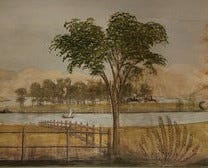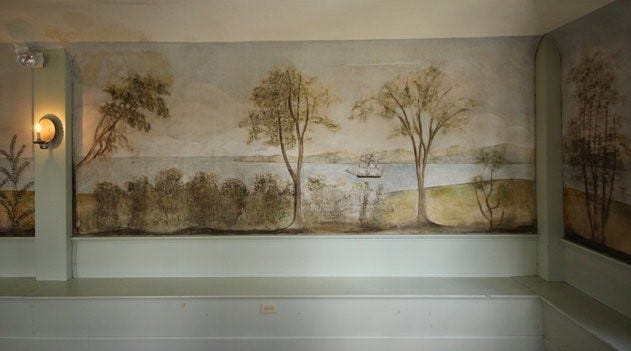Miscellany Mondays: Rufus Porter - Farmer, fiddler, traveler, artist, scientist
Rufus Porter packed a lot into his long and eventful life. Cobbler, fiddler, painter, schoolmaster, inventor, artist, writer, editor, and religious zealot. He also painted murals in one Andover home.
This post is adapted from a History Center newsletter article written in 2015 by Katherine Barr. Although Porter’s connection to Andover is limited to a single house, he holds an important place in American history.
Rufus Porter
Born in West Boxford in 1792 to a prominent farming family, Rufus Porter’s formal education ended when he was 12, after just six months at the Fryeburg (Maine) Academy.
After leaving Fryeburg Academy, Porter spent two years working as a farmer and fiddler. At 15, his parents decided it was time for young Rufus to get serious about his work, so they apprenticed him to a local shoemaker. But that didn’t last long. Porter left his apprenticeship early and moved on to Portland, Maine, where he spent three years working as a musician (fife and violin), and then “successively, a house and sign painter, a painter of gunboats, sleighs, and drums, a drummer, and a teacher of drumming.”1
In 1815, while in Portland, he married Eunice Twombly. Porter was 23 years old when they married. Between 1816 and 1836, the Porters had 10 children.2 Ever the wanderer, marriage and fatherhood didn't settle Rufus down.
The next year, the family moved to New Haven, Connecticut, where as “Professor Porter,” he ran a dancing school and started painting portraits.3 After a trading voyage to the Pacific Northwest and Hawaii between 1818 and 1819, Porter traveled throughout New York, New Jersey, Maryland, and Virginia as an itinerant portrait painter.4
To increase his productivity, Porter made a camera obscura5 to project the silhouette of the sitter onto a piece of paper. Using this outline, Porter could quickly complete his portraits at a reasonable price.6
Porter’s first wife died in 1848. In 1849, at age 56, he married to Emma Tallman Edgar from Roxbury, Massachusetts. Together they would have another six children, only one of whom survived infancy.7
In 1843, Porter became an ardent believer in the Millerite prophesy that the Last Day and Second Coming of Christ would happen in 1844. When that didn’t happen, many of Miller’s followers joined the Adventist Church.8 In 1852, Porter published Essential Truth. In the tract, Porter wrote about his religious beliefs with copious Biblical quotations.9
Wall murals
In addition to portraits, Porter traveled throughout New England painting large-scale landscape murals on plaster walls in customers’ homes. Some elements of the paintings are painted free-hand. Other elements were stenciled or stamped.
From approximately 1824 to 1840, Porter wandered from town-to-town throughout Massachusetts, Maine, and Vermont creating uniquely New England murals on the walls of inns, public buildings and private homes. Over the years most of these have been painted over, papered over, or otherwise destroyed. A small treasure trove remain, murals cherished by the owners of the buildings in which they can be found.
Porter’s wall murals remain his best-known legacy.
Rufus Porter in Andover
At the corner of Philips and Central Streets, 68 Phillips Street still has three Rufus Porter murals.
The house was built in 1763 and named “Elm Knoll” by Daniel Poor, then Deacon at South Church. It is rumored to have been Old Poor Tavern during the Revolutionary War. Sometime in the 1830s, Rufus Porter was commissioned to paint three murals in the home — two downstairs and one in an upstairs bedroom. Over the years, they disappeared under layers of wallpaper until 1916, when Andover artist H. Winthrop Pierce painstakingly restored them. The house is a private residence and not open to the public.
There are many examples of Porter's work throughout New England. In neighboring North Reading, the 1812 Damon Tavern served as a coach stop on the Salem-Lowell and Boston-Haverhill runs. As was typical of inns at that time, there is a ballroom on the second floor. All four walls feature murals by Porter. Over time, the murals were papered over several times. In the 1960s, they were uncovered and restored. Today the Tavern is open to the public on holidays and for special events.
Contact damontavern@gmail.com if you have questions about the Damon Tavern, the Rufus Porter murals, or are interested in visiting the Tavern and viewing the murals.10
Scientist
Rufus was also an inventor. He experimented with a wind-powered gristmill, a washing machine, a corn sheller, a fire alarm, a rope-making machine, and a camera. He invented clocks, railway signals, churns, a distance measuring appliance, a horsepower mechanism, a churn, a life preserver, a cheese press, and a revolving rifle.11
Scientific American
By 1845, Porter's interest in mural painting waned and he embarked on a new career as a journalist. That same year, he founded the much-celebrated Scientific American, but sold is just 10 months later.12
In 1849, he published what would become his famous treatise "Aerial Navigation," with a lengthy subtitle - "The practicability of traveling pleasantly and safely from New York to California in three days." His plan was to build an 800-foot steam-powered airship with room for 50-100 passengers. This incredible scheme, which coincided with the Gold Rush, was intended to shuttle miners to and from California.
He had already built and flown several scale models in Boston and New York. He advertised New York-to-California service, asking a $50 down payment for a $200 fare, and began building immediately. His first "aeroport" was 240 feet long; it was destroyed by a tornado. Later that year, he began a 700-foot version with new backers, but during a showing of the almost-complete dirigible on Thanksgiving Day, rowdy visitors tore the hydrogen bag and destroyed it. In 1854 his third attempt ended with technical troubles.13
A generation or two ahead of his time, its potential was never realized.
Rufus Porter’s legacy
In 1884, Rufus Porter died in Connecticut at the age of 93, leaving behind a towering legacy of art and invention that is mostly, and sadly, unrecognized and unheralded. The Scientific American noted in his obituary that “Rufus Porter will live (on) as one of the best and brightest examples of the versatility of American invention.”
Porter's obituary in the Scientific American pronounced,
"…he has gone to the grave leaving a name 'writ in water,' … We may add in conclusion that although he has not in any sense attained the fame and eminence of Morse, a Howe, or Edison, Rufus Porter will live as one of the best and brightest examples of the versatility of American invention." 14
Thanks for reading! I hope you enjoyed this story. Please like, share, and leave comments. We love hearing from History Buzz readers!
~Elaine
Jean Lipman, Rufus Porter, Yankee Pioneer, 1968, pp.4-5
Geni.com, https://www.geni.com/people/Rufus-Porter/6000000002908965575
Lipman, p.5
Rufus Porter Museum of Art and Ingenuity, https://www.rufusportermuseum.org/
What is a “camera obscura?” https://www.britannica.com/technology/camera-obscura-photography
Lipman, p.6
Geni.com
Millerites, https://ohiohistorycentral.org/w/Millerites
Lipman, p.60-62
Antiques Home Magazine, https://www.antiquehomesmagazine.com/reading-room/plaster-bits/
Geni.com
IBID
IBID
Rufus Porter Museum















I was delighted to read this. My great grandparents had a hall and their "parlor" painted by Rufus Porter. It is an old, and now restored home in Danville, NH. They are much faded but still clearly visible.